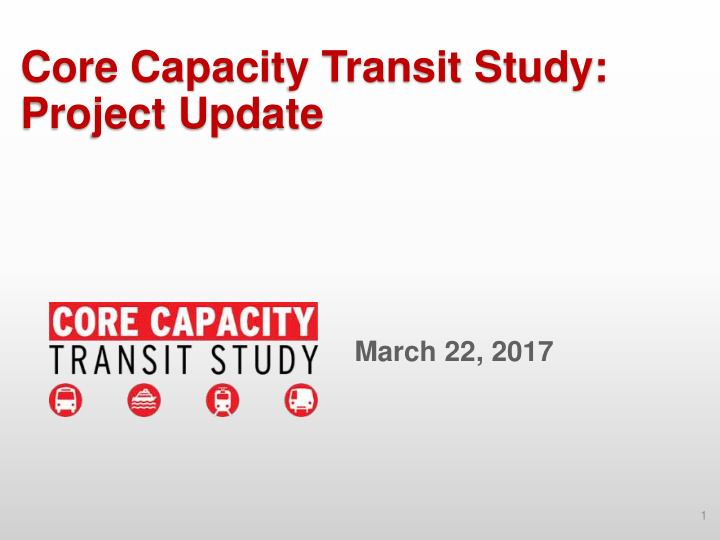



Core Capacity Transit Study: Project Update March 22, 2017 1
Outcomes for Today • Public Outreach feedback • SF Metro short and medium term recommendation • Long Term study findings • Study next steps 2
Public Outreach • Two outreach events hosted, one each in San Francisco and Oakland • Feedback included: • Prioritize comprehensive short/mid term solutions- e.g. include service and infrastructure with any pricing solutions • Long-term projects (e.g. second tube) should work to solve big regional problems • Optimize technology & traveler information so people can make better choices in real-time • Include equity in the discussion 3
SF Metro Short and Medium Term Evaluation 4
SF Metro Corridor Future Growth • Similar analysis to 6 Transbay, but capacity/demand assessed in 6 sub- 1 areas • Richmond & Sunset 2 corridors show projected demand above planned capacity • Other corridors show 3 future planned capacity 5 above projected demand 4 5
SF Metro Sunset Corridor Capacity and Demand: Prerequisites • Capacity/crowding issues most urgent in Sunset/Muni Metro corridor • Limits to scheduled capacity: Current maximum of two- car consists and use of one-car consists on some lines (capacity in most of MMT for four-car consists) • Limits to realized capacity: Travel time variability in surface portions of rail system prevent SFMTA from operating tunnel to its train-capacity potential • Potential: 40+ trains per hour • Scheduled: 36 trains per hour • Realized: Likely often <36 trains in peak hours
Short/Medium-Term Packages Focus on Improving Train Operations on City Streets 1a • Scheduled Capacity: Lengthen trains throughout the system • Realized Capacity: Limit travel-time variability on surface Join Trains at Merge Points to Increase Tunnel 1b Capacity • Scheduled Capacity: Lengthen trains in core of system Simplify the Structure of the System 2 • Scheduled Capacity: Lengthen trains on key lines • Realized Capacity: Reduce tunnel exposure to surface variability 7
Current System Structure
2a: Restructure – Church Station Transfer
2c: Restructure – Spine-Transfer
Evaluation Results Metrics Conclusions 11
Performance Evaluation (Relative to baseline/no-build) Capacity Utilization Reliability Resiliency Peak Hour Surface Travel Relative Load Factor Person Spaces Time Variance Assessment Package 1a Package 2a Package 2c Lower performing Higher performing
SF Metro Capacity and Demand w/ Package 1a (Surface Optimization)
Recommended Package 1a: Capital Costs Improvements Estimated Cost Not Fully Funded Prerequisite Projects SFMTA – Fleet and Yard 1 $787M 2 Surface Light Rail Safety & Capacity Project $100M Subtotal Prerequisite Projects $887M Not Fully Funded Recommended Projects 1 Surface Improvements $51M - Station improvements - Roadway improvements - Transit priority traffic control improvements Subtotal Recommended Projects $51M Total Recommended Package $938M 14
Next Steps • Investment in pre-requisite projects • Continued and enhanced implementation of travel time and reliability improvements for light rail lines • ConnectSF – Citywide identification of long term priorities and key travel corridors 15
Long Term Summary 16
Long Term Options Long Term Option Capacity Capital Cost Estimate Estimate 1 More Bus and Ferry: Maximize Existing +13,000 $600M Assets - +125 buses - +6 ferries 2 BART Independent Line (via Mission) +30,000 $5B - $12B -28 trains/hour BART Independent Line (3 rd St. Crossing) 3 +30,000 $5B - $12B - 28 trains/hour +10,000 – 4 BART Merged Line (SOMA/Mission Bay) $5B - $12B 20,000 - 12 to 24 trains/hour +12,000 – 5 Greater Regional Rail Connection $5B - $11B - 10 to 12 trains/hour 18,000 17
Long Term Options – SF Alignments BART BART Independent Independent Line – 3 rd St. Line – via Mission St. Crossing #2 #3 BART Greater Merged Regional Line – SOMA/ Rail Mission Bay Connection #4 #5 18
Transbay Capacity and Demand: Short and Medium Improvements 19
Transbay Capacity and Demand: More Bus and Ferry 20
Transbay Capacity and Demand: BART Independent Line 21
Transbay Capacity and Demand: BART Merged Line 22
Transbay Capacity and Demand: Greater Regional Rail 23
Transbay Capacity and Demand: BART + Conventional Rail 24
Long Term Summary • All options deliver sufficient capacity to meet demand for the medium growth 2040 forecast • However, two options (bus and ferry option and BART Merged/Breakout Line) do not deliver sufficient capacity for the high-growth forecast • All other rail options provide sufficient capacity for the high growth 2040 forecast • Recommend a long term project to provide additional transit capacity in the corridor for 2030+ 25
Next Steps • Develop and issue Final Report • Second crossing continuation study • Includes BART and conventional rail option for analysis • Need to Identify study leaders – Identify program management role and who does it – BART will lead BART portion – Responsible entity to lead conventional rail portion needs to be identified/created • Extend PMT participation (and new stakeholders) • Study anticipated to look at market demand first, then service needed to address demand, then operations and infrastructure • Key scoping questions • Geographic scale: corridor, regional, mega-regional? • Institutional governance and other policy considerations • A scoping effort is needed ASAP to develop a second crossing continuation study framework. • Recommend Execs meet again to outline continuation effort 26
Questions? 27
Recommend
More recommend